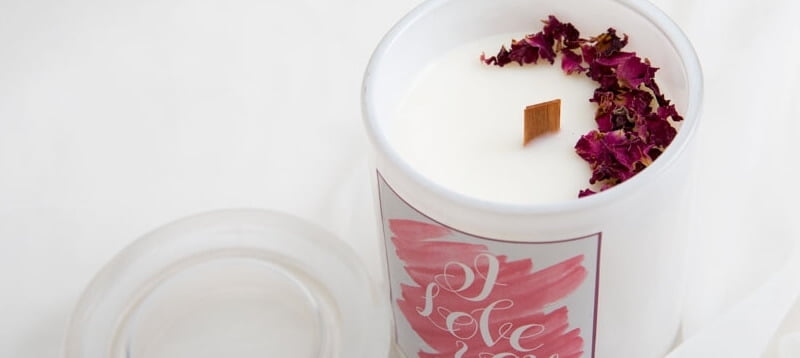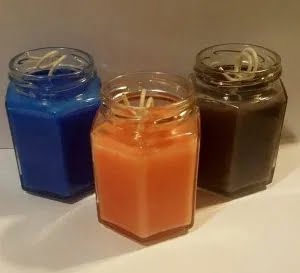Blending soy and coconut wax for candle making is a popular technique that can greatly enhance the quality of your candles. By combining the unique properties of these two waxes, you can achieve a superior scent throw and longer burn time compared to using just one type of wax.
This article will guide you through the process of blending soy and coconut wax, providing all the necessary information and step-by-step instructions to help you create beautiful and long-lasting candles.
In this introductory section, we will explore the benefits of blending soy and coconut wax for candle making. Understanding these advantages will not only motivate you to try this method but also help you appreciate the science behind achieving optimal candle performance.
By blending soy and coconut wax, you can take advantage of the best qualities of each type. Soy wax is known for its excellent scent throw, while coconut wax has a longer burn time. Blending them together allows for an optimized balance between fragrance diffusion and candle longevity. Additionally, both soy and coconut waxes are natural and renewable resources, making them environmentally friendly choices for candle making.
Whether you’re a beginner or an experienced candle maker, knowing how to blend soy and coconut wax is a valuable skill that can elevate your craft. So let’s dive into the comprehensive comparison between soy wax and coconut wax in the next section, where we’ll explore their differences in detail.
Understanding the Difference between Soy Wax and Coconut Wax
When it comes to candle making, understanding the differences between soy wax and coconut wax is essential for achieving the desired results. Both types of wax have their own unique characteristics and qualities that can greatly impact the final product. In this section, we will provide a comprehensive comparison of soy wax and coconut wax to help you make an informed decision when blending these two waxes together.
Composition and Source
Soy wax is made from the oil of soybeans, which are a renewable resource. It is biodegradable and derived from a natural source, making it an eco-friendly option for candle making. On the other hand, coconut wax is made from the oil of coconuts. Like soy wax, coconut wax is also a renewable resource and biodegradable.
Appearance and Texture
In terms of appearance, soy wax has a creamy white color, while coconut wax has a slightly off-white or ivory color. When it comes to texture, soy wax is typically softer and easier to work with compared to coconut wax. Coconut wax has a denser consistency, which can make it more challenging to handle during the candle-making process.
Fragrance Throw and Burn Time
One significant difference between soy wax and coconut wax lies in their fragrance throw and burn time. Soy wax has excellent scent throw capabilities, allowing candles made with this type of wax to fill a room with fragrance quickly. Additionally, soy candles tend to have longer burn times compared to other types of candles.
On the other hand, while coconut wax does not have as strong of a scent throw as soy wax, it still provides a pleasant fragrance experience. Coconut candles also tend to have shorter burn times compared to soy candles.
By understanding these differences between soy wax and coconut wax, you can determine how they will interact when blended together for your candle-making venture. Whether you want enhanced scent throw or a specific burn time, knowing the characteristics of each wax will help you make an informed decision when creating your own unique blends.
The Advantages of Blending Soy and Coconut Wax
Blending soy and coconut wax in candle making offers several advantages, particularly when it comes to enhancing scent throw and burn time.
Scent throw refers to the strength and diffusion of the fragrance emitted by a candle when lit. The combination of soy and coconut wax creates a superior scent throw compared to using either wax alone. Soy wax has excellent fragrance retention, meaning it holds onto scents well.
However, it can have a weaker scent throw on its own. On the other hand, coconut wax has a more significant scent throw but is not as good at retaining fragrance. By blending these two waxes together, you can achieve optimal fragrance performance in your candles.
Another advantage of blending soy and coconut wax is the extended burn time it provides. Soy wax burns slower than most other waxes due to its low melting point and dense composition. It also creates a more even burn, reducing wastage and ensuring that the candle lasts longer.
Coconut wax has a higher melting point but melts consistently without tunneling or leaving unburned spots around the edges of the container. Combining these two waxes allows for a longer-lasting candle with an even burn throughout.
| Wax Type | Scent Throw | Burn Time |
|---|---|---|
| Soy Wax | Good (fragrance retention) | Longer (slower burn) |
| Coconut Wax | Excellent (strong diffusion) | Longer (consistent burn) |
| Soy and Coconut Wax Blend | Superior (optimal fragrance performance) | Extended (even burn throughout) |
Selecting the Right Ratio
When it comes to blending soy and coconut wax for candle making, finding the right ratio is crucial in order to achieve the perfect balance between the two waxes. The ideal ratio will vary depending on personal preference and desired candle characteristics. However, there are some general guidelines that can help you navigate through this process.
One commonly recommended starting point is a 50/50 blend of soy and coconut wax. This equal combination allows you to experience the benefits of both waxes and create a well-rounded candle. It provides a good scent throw, clean burn, and smooth texture.
If you prefer a softer and creamier texture, you may want to increase the percentage of coconut wax in your blend. A ratio of 60% coconut wax and 40% soy wax can help achieve this effect. On the other hand, if you desire a firmer and more opaque candle, increasing the percentage of soy wax to 60% or even 70% would be recommended.
It’s important to note that each wax has its own unique qualities, so experimenting with different ratios is key to finding what works best for you. Keep in mind that certain fragrance oils may perform differently when mixed with different waxes, so it’s always a good idea to test small batches before making larger quantities.
- Start with a 50/50 blend of soy and coconut wax
- Increase coconut wax for a softer texture (60% coconut / 40% soy)
- Increase soy wax for a firmer texture (70% soy / 30% coconut)
Finding the perfect balance between soy and coconut wax requires experimentation and tinkering with ratios until you achieve your desired results. Take notes on each batch that you make, noting any changes in scent throw, burn time, or overall performance.
Remember that personal preference plays a major role in selecting the right ratio for your blended wax. Trust your senses and keep testing until you find the ideal combination that meets your specific needs and creates beautiful, high-quality candles.
Essential Tools and Ingredients for Blending Soy and Coconut Wax
To successfully blend soy and coconut wax for candle making, it is important to have the essential tools and ingredients on hand. Having the right equipment and supplies will ensure that the blending process is efficient and that the resulting candles turn out beautifully. Here are some key tools and ingredients you will need:
- Wax: Of course, the main ingredients for blending soy and coconut wax are soy wax and coconut wax themselves. It is recommended to use a clean, natural soy wax without additives, and a high-quality coconut wax that has a low melting point.
- Double Boiler or Melting Pot: A double boiler or melting pot is essential for melting the waxes together gently without causing them to scorch. This equipment helps to create a slow, even heat distribution.
- Thermometer: To achieve the perfect balance between soy and coconut wax, it is crucial to monitor their temperature during the blending process. A thermometer will allow you to accurately measure the temperature of your wax blend.
- Fragrance Oils or Essential Oils: Adding fragrance oils or essential oils can enhance the scent throw of your candles. Make sure to choose high-quality oils specifically designed for candle making.
- Dyes or Color Blocks: If you want to add color to your candles, you will need dyes or color blocks specifically made for candle making. These should be oil-soluble so that they mix well with the blended wax.
- Wick Sustainers and Candle Wicks: To properly burn your candles, you will need wick sustainers and candle wicks of an appropriate size for your container candles.
- Containers: Lastly, you will need containers to pour your blended wax into. Consider using glass jars or tins that are suitable for candle making.
Having these essential tools and ingredients on hand will enable you to begin blending soy and coconut wax effectively for candle making projects. With these supplies at your disposal, you can proceed to the step-by-step guide in the next section to learn how to properly blend soy and coconut wax for the best results.
Step-by-Step Guide
Blending soy and coconut wax for candle making can be a rewarding and creative process. By combining these two types of wax, you can benefit from their unique properties to create candles with enhanced scent throw and burn time. In this section, we will provide a step-by-step guide on how to properly blend soy and coconut wax for candle making.
Step 1: Gather your supplies
Before you begin blending the waxes, make sure you have all the necessary tools and ingredients. You will need a double boiler or a melting pot, a thermometer, a stirring utensil (such as a wooden spoon), wicks, fragrance oils or essential oils (if desired), and of course, soy wax and coconut wax.
Step 2: Measure and melt the waxes
Start by measuring the desired amount of soy wax and coconut wax according to your chosen ratio. A common starting point is a 50/50 blend, but you can experiment with different ratios to achieve your desired results. Place the wax in the double boiler or melting pot and heat it gently until it completely melts. Make sure to monitor the temperature using the thermometer to ensure it stays within safe limits.
Step 3: Stir and mix thoroughly
Once both waxes have melted together, stir them gently but thoroughly. Aim for an even blend, ensuring that there are no streaks or clumps of unmelted wax remaining. This step is crucial for achieving consistent results throughout your candles.
Step 4: Add fragrance (optional)
If you wish to add fragrance to your candles, now is the time to do so. Measure out your preferred amount of fragrance oil or essential oil and slowly pour it into the melted wax mixture. Stir continuously for about two minutes to ensure that the fragrance is evenly distributed throughout the blend.
Step 5: Pour into containers
Now that your blended wax mixture is ready, carefully pour it into your chosen containers. Ensure that you have prepped your containers with wicks and secured them in place before pouring the wax. Leave some space at the top to allow for expansion during cooling.
Remember, candle making is an art form, and it may take some experimentation to find the perfect ratio and technique that yields your desired results. By following this step-by-step guide, you are well on your way to creating beautiful candles using a blend of soy and coconut wax.
Troubleshooting Tips
When blending soy and coconut wax for candle making, it is important to be aware of the common challenges that may arise during the process. By understanding these challenges and knowing the appropriate solutions, you can ensure a successful blend and achieve high-quality candles. Here are some troubleshooting tips to help you overcome any issues that may arise:
Poor Scent Throw
One common challenge when blending soy and coconut wax is achieving a strong scent throw. If your candles have a weak fragrance, it could be due to various factors such as using low-quality fragrance oils or not adding enough fragrance oil to the wax. To improve scent throw, consider investing in high-quality fragrance oils specifically designed for soy and coconut wax blends.
Additionally, make sure to follow the recommended usage rates provided by the manufacturer. You may also try increasing the amount of fragrance oil in your blend slightly, but be cautious not to add too much as it can impact the burn quality.
Uneven Burning
Uneven burning is another issue that can occur when blending soy and coconut wax. This can result in tunneling, where the candle burns down in a narrow tunnel instead of evenly across the entire surface.
To prevent this problem, ensure that you are using the correct wick size for your candle jar’s diameter. A wick that is too small will not create enough heat for the wax to melt evenly, while a wick that is too large can cause an excessive flame size and potentially lead to an unsafe burn condition.
Frosting
Frosting refers to the white crystalline patterns that sometimes appear on the surface of soy and coconut wax blend candles. While frosting does not affect the performance of the candle, it can impact its aesthetic appeal. To minimize frosti.
Enhancing the Aesthetic Appeal
Adding colors and fragrances to the blended wax is an important step in creating visually appealing and enticing candles. By incorporating various colors and scents, you can enhance the overall aesthetic appeal of your candles and create a multi-sensory experience for your customers. Here are some tips on how to effectively add colors and fragrances to your soy and coconut wax blend for candle making.
When it comes to adding colors to your blended wax, there are several options available. One popular method is using liquid candle dyes or dye chips specifically designed for candle making. These dyes come in a wide range of vibrant colors that can be easily mixed into the melted wax.
Start by adding small amounts of dye to achieve your desired shade, as a little goes a long way. Remember to stir the wax thoroughly after adding the dye to ensure even distribution.
Another option for coloring your blended wax is using natural colorants, such as botanicals or herbs. These can be added directly into the melted wax or infused into oils that will later be added to the blend. Not only do natural colorants provide unique shades, but they also add texture and interest to the finished candles.
In terms of fragrance, there are countless options available in the form of fragrance oils specifically formulated for candle making. These oils are designed to withstand the heat of burning and provide a strong scent throw when used in candles. When selecting fragrance oils, consider choosing scents that complement or enhance the theme or purpose of your candles. Whether you prefer floral notes, fruity aromas, or warm and cozy scents, there is sure to be something for everyone.
To incorporate fragrance oils into your blended wax, it’s best to add them once the wax has cooled slightly but not solidified completely. This will ensure that the fragrance oil blends well with the wax without evaporating too quickly.
Follow the recommended usage guidelines provided by the manufacturer when determining how much fragrance oil to add per pound of wax. Remember that different fragrance oils have varying strengths, so it’s important to start with a smaller amount and add more if desired.
Usage and Storage Guidelines
Properly handling and caring for soy and coconut wax blend candles is crucial to ensure their longevity and optimal performance. By following some usage and storage guidelines, you can extend the life of your candles and enjoy the benefits they offer.
Firstly, when lighting your soy and coconut wax blend candle, it is important to trim the wick to approximately 1/4 inch before each use. This will help prevent the flame from getting too large and causing excessive heat or smoke. It is also advisable to avoid placing the candle near drafts or flammable objects to ensure a safe burning environment.
During the initial burn, it is recommended to allow the candle to create a melt pool that reaches close to the edges of the container. This can take around 2-3 hours, depending on the size of the candle. Allowing this melt pool will help prevent “tunneling,” where only a small portion of wax melts in subsequent burns, resulting in wasted wax along the sides of the container.
When extinguishing your soy and coconut wax blend candle, using a snuffer or gently blowing out the flame is preferable over directly dipping it into the melted wax. This practice helps maintain a clean burn without causing excessive smoke or blackening of the container.
In terms of storing your candles, it is essential to keep them in a cool and dry place away from direct sunlight. Excessive heat can cause melting or softening of the wax, which can affect their performance when burned later on. Additionally, prolonged exposure to sunlight may fade any colored dyes used in the candles.
To further protect your soy and coconut wax blend candles during storage, cover them with lids or secure them with plastic wrap or aluminum foil. This will prevent dust accumulation on the surface as well as preserve their scent until you are ready to use them again.
By following these usage and storage guidelines for handling and caring for your soy and coconut wax blend candles, you can maximize their lifespan and enjoy the beautiful ambiance and scent they provide.
Conclusion
In conclusion, blending soy and coconut wax for candle making offers a multitude of benefits that make it an attractive option for both beginners and experienced candle makers. As we have explored throughout this article, combining these two waxes not only enhances the scent throw and burn time of the candles but also provides a more sustainable and eco-friendly alternative to traditional paraffin wax.
By understanding the difference between soy wax and coconut wax, one can appreciate their unique qualities and how they work harmoniously when blended together. Experimenting with different ratios of soy and coconut wax allows you to find the perfect balance that suits your desired scent throw and burn time preferences.
To successfully blend soy and coconut wax, it is essential to have the right tools and ingredients at hand. From double boilers to accurate thermometers, investing in quality equipment ensures that your candle-making process is efficient and safe.
Once you have mastered the art of blending soy and coconut wax, don’t be afraid to enhance the aesthetic appeal of your candles by adding colors and fragrances to the blended wax. This allows you to create unique and personalized candles that reflect your own signature scent.
Frequently Asked Questions
Can you mix soy and coconut wax for candles?
Yes, it is possible to mix soy and coconut wax for candles. This blend combines the benefits and qualities of both waxes, allowing for a unique candle-making experience. Soy wax is derived from soybean oil and is known for its eco-friendly nature, clean burn, and excellent scent throw.
On the other hand, coconut wax is made from coconut oil and offers a smooth texture, good fragrance retention, and aesthetic appeal. By mixing these waxes together, you can potentially create a candle with both characteristics.
Is a soy and coconut wax blend good?
A soy and coconut wax blend can be an excellent choice for candle making. When combined, these waxes complement each other’s strengths and enhance the overall performance of the candle. The soy wax provides a cleaner burn with reduced soot production while enhancing fragrance release.
Meanwhile, the addition of coconut wax adds to the candle’s luxurious feel due to its creamy texture and improved scent retention capabilities. Additionally, this blend often results in a visually appealing finish. Ultimately, the choice of using a soy and coconut wax blend will depend on personal preferences as well as specific requirements for your candles.
What is the ratio of coconut wax to blend?
The ratio of coconut wax to soy in a blend can vary depending on personal preferences or desired outcomes for the candles being made. Generally speaking, there isn’t a fixed ratio that applies universally to all candle makers. Some individuals may prefer a higher proportion of soy wax in the blend while others might opt for more coconut wax.
Experimenting with different ratios allows you to find what works best for your specific needs – whether it’s achieving optimal fragrance throw or creating unique visual effects in your candles’ appearance. It is recommended to start with equal amounts of each type of wax (50:50) as a starting point and then adjust as necessary based on your desired results through testing and experimentation process.

Welcome to my candle making blog! In this blog, I will be sharing my tips and tricks for making candles. I will also be sharing some of my favorite recipes.





